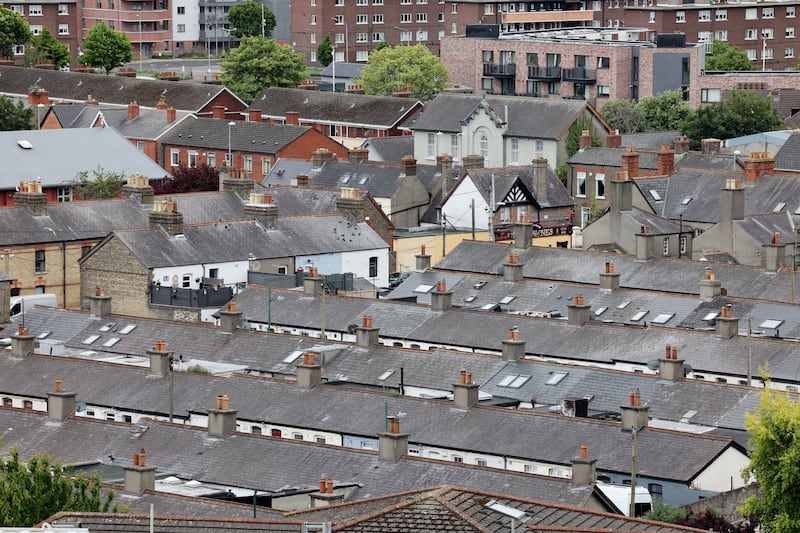Would-be Dublin homeowners are being left in a difficult place due to a lack of affordable homes in the capital and few new-builds priced below the threshold for which purchase grants are available.
There was a time when young people could rent in Dublin and enjoy the capital while saving for a deposit to buy. Indeed, in 1991, the age by which two-thirds of people owned their own home was 28.
Since then, the median age of first-time buyers has risen to 35, its highest on record. Some 44 per cent of first-time buyers are over 35. People who grew up in Dublin used to be able to live within reach of family and schoolfriends if they wanted to. Those from other counties could plan for a life in the capital after studying there, knowing their friends could too. Living in Dublin was a possibility.
However, that ship has sailed for many. For first-time buyers of new-build homes in Dublin who are availing of the First Home shared-equity and Help-to-Buy schemes, there are purchase price limits of €475,000 and €500,000 respectively, and the schemes are not available to those buying second-hand properties. This means Dublin and its older, more-established suburbs are simply no longer an option for young buyers.
READ MORE
Add to that preferable mortgage interest rates for higher energy-rated homes – more typically new-builds and more expensive second-hand homes – and it is understandable that the next generation feel edged out.
These factors are dispersing them further from family, school and college networks, and from the social and cultural life of the city. So, if you are a first-time buyer and you want to remain in Dublin, what are your options?
Bank of mum and dad
The Dublin region had the highest median house price in the country at €445,000 in the year to February, according to Central Statistics Office figures. At that price, it’s no wonder first-time buyers are leaning on mum and dad where they can.
Almost 42 per cent of first-time buyers used gifts to help fund their deposits, according to the Banking and Payments Federation (BPFI). Help from family members amounted to more than €149 million in the first half of 2021 alone, it found.
“There is a cohort who grew up in certain parts of Dublin who will only buy a home close to that area, and will get help in order to do so,” says estate agent Owen Reilly. “I’m not sure how much of a housing market we would have in South Dublin if it wasn’t for first-time buyers getting help.”
[ A home of your own: What is in the housing plan for under-40s?Opens in new window ]
To buy a home at the Dublin region’s median price of €445,000, you would need a €45,000 deposit and income of €111,000. Yes, that’s below the €500,000 first-time-buyer grant threshold, but that, it turns out, is moot. You won’t get a grant unless you buy a new-build and there are few at that price being built in Dublin.
In mid-April, there were two listings of new-builds for sale on myhome.ie below the €500,000 grant threshold. One was a one-bed 54sq m apartment at Seamount Rise in Malahide, about a 40-minute drive from the city centre, from €450,000. The other was a two-bed 88sq m apartment at Tandy’s Lane in Lucan. From Adamstown train station that is a 30-minute journey to Connolly station from this property, also priced from €450,000.
And it’s not just grants that are pushing first-time buyers further out, but house prices too, says Pat Davitt, chief executive of the Institute of Professional Auctioneers and Valuers (Ipav).
“I think the grants are good. I think in Dublin the scheme limits are going to have to be adjusted though if first-time buyers are going to be in with an equal opportunity to buy properties there,” says Davitt.
Indeed, of new homes built in Dublin last year, some 72 per cent were apartments. With the average first-time buyer now aged 35, this life stage is out of kilter with what they can afford: a couple in their mid-30s planning a family, for example, will quickly outgrow a one- or two-bed apartment.
Homes in Dún Laoghaire-Rathdown, which includes suburbs such as Dundrum, Dún Laoghaire, Sandyford and Shankill, had the highest median price in the capital at €620,000.
In those areas in mid-April, there was just one new-build under the €500,000 grant threshold listed on myhome.ie. So for first-time buyers looking in those areas, Government grants are of little help.
“You can’t ignore the bank of mum and dad, gifts are still a very prominent part of the process,” says Michael Dowling of mortgage broker Dowling Financial.
“I don’t know of any first-time buyer over the past four or five years who hasn’t got a gift of some description. For some it’s €10,000 but for others you’d be frightened at the amount of money they are getting from parents,” says Dowling.
Make a lateral move

Another option being taken by those who cannot afford to live in the suburb where they grew up, or the one in which they have been renting, is to make a lateral move.
Ross Forde of David Ross Estate Agents, which operates in Walkinstown, Drimnagh and Crumlin, is seeing an influx of buyers from neighbouring suburbs that were once worlds away.
“I am noticing there are a lot more people coming in from Terenure, Kimmage and Harold’s Cross, people who grew up in Dublin 6. Those areas are not affordable, so they seem to be heading down here more and more,” says Forde.
Crumlin, Drimnagh and Walkinstown, traditionally more working-class areas with a large stock of local authority houses, are as close to the city as their more easterly neighbours. The difference in house prices between Dublin 6 and 6W and Dublin 12, however, is stark.
A second-hand three-bedroom home in Crumlin and Drimnagh that needs work starts from about €350,000, says Forde. Homes that have already been extended, wired and plumbed are selling for between €400,000-€450,000.
Stock, however, is the issue.
“Usually the transition would be Crumlin, Drimnagh, Walkinstown owners moving up to Templeogue, Rathfarnham or Knocklyon,” says Forde, but prices in those areas have become unaffordable.
“There is nowhere for them to move to. The number of owners ringing saying they want to go to market is less and less.”
Homes in Dublin 12 date from the 1930s and some first-time buyers are getting a foothold through generational turnover.
“I did 14 valuations last week and out of those 14, I think eight were for Fair Deal and the other six were for probate,” says Forde.
“These houses are moving like hot cakes but the question of the year we get is: ‘Is this property eligible for the vacant-homes scheme or the derelict-homes scheme?’ We are getting that question more and more.”
Where the property has been vacant for two years, buyers can get a grant of up to €50,000 to renovate and up to €70,000 if the property is derelict.
Movers are young professional couples and single buyers. “You’d want to be earning €100,000 to buy in this neck of the woods, you are talking technology workers and solicitors,” Forde says.
With the migration from Dublin 6 and 6W along with planning granted for a significant revamp of Dunnes Stores at the city end of the Crumlin Road to comprise a food market and cafes, some are lightheartedly referring to Crumlin as “Ranelagh West West”.
Pockets of value
There are still some pockets of value close to the city if buyers are prepared to think beyond the areas they might know.
“I do think the north inner city, around Mountjoy Square and towards Croke Park, is undervalued,” Reilly says. “You could say the area has its challenges, but there is value there.” He mentions East Wall as another area he thinks is undervalued.
“There is value in the neighbourhoods around St James’s Gate that are going to see a lot of regeneration,” Reilly says. The new children’s hospital, employing more than 5,000 people, is due to open next year.
“In Crumlin and Drimnagh, there is definitely less value there than there was, but there are pockets in Rialto and Inchicore still. Slowly, I think the cost of refurbishment is being factored into selling prices,” Reilly says.
Two-thirds of first-time buyers buy second-hand homes, according to figures from the BPFI.
There are grants to renovate vacant and derelict second-hand properties and Sustainable Energy Authority of Ireland grants to insulate them, and first-time buyers should be helped to buy them, Davitt says.
“Why shouldn’t they get a grant to buy a second-hand property? They are getting their own money they have paid in tax back, why shouldn’t they get it back for a second-hand property?
“In our budget submission, we will be looking for the €500,000 first-time buyer grant to be extended, and we will be looking for the first-time buyers grant to be extended to second-hand homes.”
Some first-time buyers are finding value in apartments, particularly those that are heavily rent-capped where they will face little or no competition from landlords.
“In the docklands, the market has completely switched from investor-driven to owner-occupier driven. Ten years ago, 80 per cent of our buyers were investors, now 80 per cent are owner-occupiers. They are techies, they are high earners who are deciding to buy instead of paying rent. They are happy to stay close to their offices and networks,” says Reilly.
Say goodbye
A final option for frustrated would-be Dublin dwellers is to quit the place altogether and move to where they can live alongside thousands of other Dubliners who have done the same.
“Previously, you might be showing someone an apartment in the docklands and they might be viewing a house in Stillorgan,” says Reilly. “Now they might be viewing a house in Arklow or Drogheda too.”
He is struck by the vastly expanded search parameters of buyers. “There are people starting their search in the city and suburbs who we know are also looking at homes in Dunshaughlin, Navan or Naas,” Reilly says.
“What wasn’t happening before is you could be meeting a first-time buyer in the docklands or Ringsend who is also looking at new homes in Bray. That wasn’t really a feature of the market before. That is being driven by the grants.”
First-time buyers prepared to venture further could find themselves paying less money, getting a bigger house for their buck and qualifying for Government grants to buy it.
Head down the M11 to the outskirts of Wicklow town, for example, and a first-time buyer could get a four-bed, three-bath, semidetached home in Brookfield Park for €485,000. A cash deposit of €18,500 combined with the Help to Buy grant of €30,000 will give them a deposit of €48,500. They will need to borrow €436,500 and would need a household salary of about €109,000, or €54,500 each for a couple.
It’s still a lot of money, but they are getting more for it. The home is A-rated, so they will qualify for a cheaper mortgage too. Moreover, the house is five minutes from the M11 motorway or, in Dublin terms, 48km to the Spire.


















